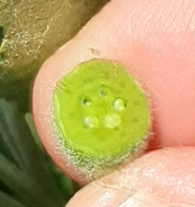Tree Fruit Thinning Concerns

Now that fruitlets are starting to show signs of fruit set and growth, decisions about whether or not to apply a thinner can be made if sufficient flowers survived the May 18th freeze. Highmoor Farm has a few orchards that had less than 20% damage, so fruit set looks heavy. In these orchards that seem to need thinning, my plan is for a low rate of 6-BA (Maxcell®, Rite-Way®, Excellis®). Another option is the normal rate of carbaryl (Sevin®).
In some orchard blocks with signs of good fruit set, I have observed fruitlets with poor seed development which concerns me. The lack of seed development could indicate that these fruitlets will be very easy to overthin or prone to a heavy June drop, so a very light approach to thinning is what I am suggesting in orchard blocks that need to have clusters thinned to one fruit. If you find more than two fruits per cluster and most clusters setting fruit, you should consider thinning. Check fruitlets for signs of obvious seed development. Some fruitlets are growing in size despite having injury to the seed cavity.
McIntosh and Cortland king fruit are ranging in size from 7 to 10 mm, but are at a good stage for thinning if needed.
Honeycrisp and Golden Delicious fruitlets range in size from 4 to 8 mm, so my plan is wait and check these blocks again in a few days.

The temperatures Thursday will be hot and likely to cause excessive thinning, so I am recommending that you wait till after this when temps will cool down.
In half our orchard blocks, we have 70 to 95% loss of flowers. These orchards will not need any chemical thinners.
Where brand names or company names are used, it is for the reader’s information. No endorsement is implied nor is any discrimination intended against products with similar ingredients. Always consult product labels for rates, application instructions and safety precautions. Users of these producers assume all associated risks.
The University of Maine is an equal opportunity/affirmative action institution.
